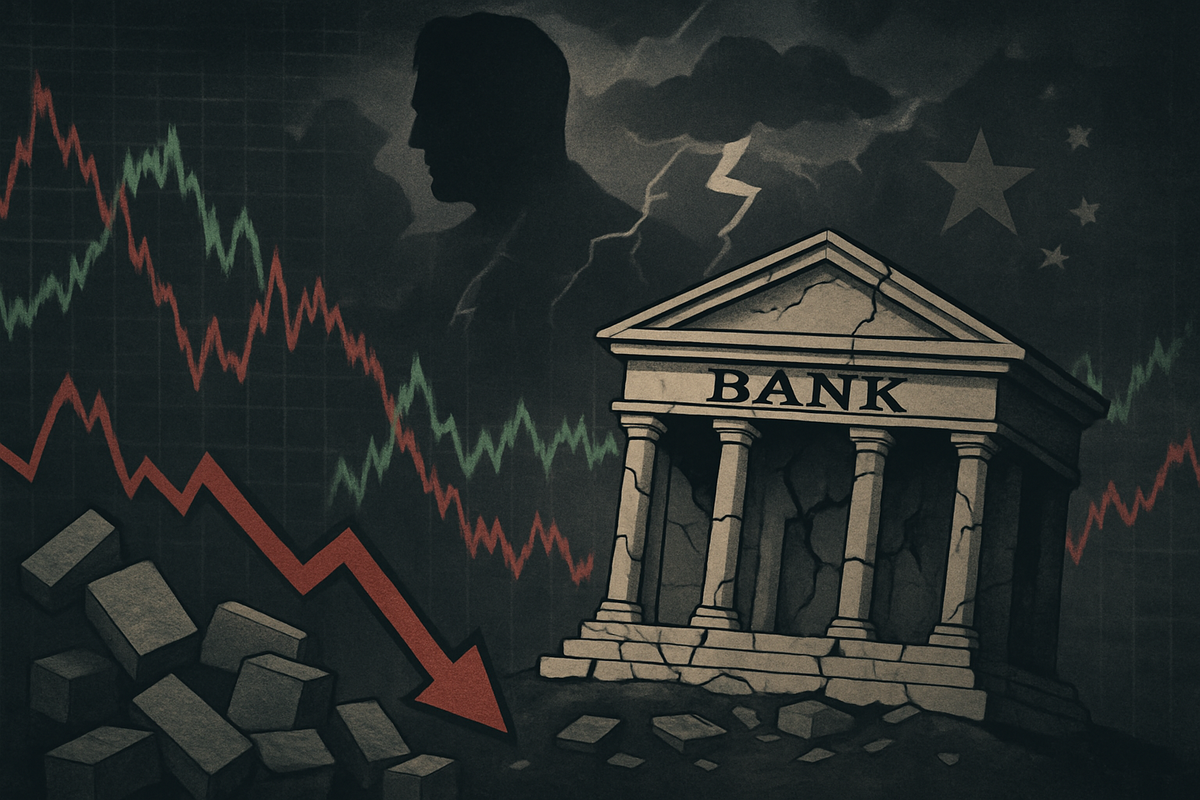
The global stock market finds itself in a precarious position, grappling with a dual assault of geopolitical uncertainty and domestic financial instability. Former President Donald Trump's recent addresses regarding China have sent shockwaves through equities, with the market swinging wildly in response to his shifting rhetoric on tariffs. Simultaneously, fears over the credit quality and exposure to bad loans within the regional banking sector have escalated dramatically, spurring an exodus by investors to safe havens and reigniting anxieties about the broader financial system.
This confluence of events, unfolding in mid-October 2025, has fostered an environment of heightened volatility and investor caution. The prospect of renewed trade hostilities with China threatens to disrupt global supply chains and corporate earnings, while the specter of failing loans in regional banks raises questions about the health of the U.S. economy and the stability of its financial institutions.
Geopolitical Tensions and Financial Fault Lines: A Deep Dive into Market Movers
The past week has been a whirlwind of market-moving headlines, with the narrative largely dictated by developments on two distinct but equally impactful fronts. On Friday, October 10, 2025, Donald Trump, in a stark declaration, threatened to impose an additional 100% tariff on Chinese imports beginning November 1. Citing Beijing's "extremely hostile" export controls on rare earth minerals, Trump's announcement triggered an immediate and sharp sell-off across global markets. The S&P 500 plummeted 2.7%, the Nasdaq Composite dropped 3.6%, and the Dow Jones Industrial Average shed nearly 880 points, marking the worst single-day sell-off for US equities since April. Technology stocks, particularly major chipmakers like Nvidia (NASDAQ: NVDA) and Broadcom (NASDAQ: AVGO), were disproportionately affected due to their extensive reliance on China for manufacturing, raw materials, and significant sales growth. In response to the escalating uncertainty, gold prices surged by 1.5% to $4,035 per ounce as investors flocked to traditional safe-haven assets, while crude oil futures dropped by 5.3%, and the U.S. dollar index fell, signaling reduced investor confidence.
However, the market's trajectory took an abrupt turn just days later. On Sunday, October 12, and again on Friday, October 17, Trump softened his hawkish stance, indicating that such high tariffs might not be sustainable long-term and expressing a desire for the U.S. to "help, not hurt" China. He also alluded to a planned meeting with Chinese President Xi Jinping in South Korea, hinting at potential avenues for trade negotiations. This unexpected shift in rhetoric provided a temporary reprieve for markets. On Monday, October 13, the S&P 500 surged 1.5%, the Dow Jones Industrial Average added 1.2%, and the Nasdaq Composite jumped 2%. This pattern of dramatic swings based on Trump's pronouncements echoes similar market reactions observed in April, where initial tariff threats were subsequently followed by more conciliatory remarks. Despite the temporary rebound, underlying trade tensions, fueled by China's tightened controls on rare earth exports and the U.S. administration's intent to enforce tougher restrictions on chip-design software, continue to contribute to broader market jitters.
Compounding the geopolitical unease, the regional banking sector has become a significant source of market instability, reigniting fears about overall credit quality and potential contagion within the U.S. financial system. On Thursday, October 16, and Friday, October 17, regional bank stocks tumbled sharply following alarming disclosures from Zions Bancorporation (NASDAQ: ZION) and Western Alliance Bancorporation (NYSE: WAL). Zions Bancorporation announced a $50 million charge-off related to two bad loans, coupled with a $60 million provision for credit losses attributed to "apparent misrepresentations and contractual defaults." Shares in Zions plunged by over 10%. Concurrently, Western Alliance Bancorporation reported grappling with a fraudulent borrower and initiated legal proceedings over a bad loan reportedly worth $100 million, causing its shares to drop more than 9%.
These disclosures swiftly reignited investor fears about the health of the regional banking sector, spreading concern across the broader financial landscape. The KBW Regional Banking Index (KRE) plummeted 6.3% on October 16, with nearly all its constituent banks closing sharply lower. The sell-off also impacted the wider market, with the S&P 500 down 0.7% and the Dow Jones down 0.6% on the same day. Global stock markets, including those in Europe and Asia, experienced significant declines, and gold hit a new record high of $4,378 per ounce as investors sought safety. These incidents have revived concerns about lax lending practices and potential financial instability in mid-tier banks, echoing the tremors felt more than two years after the Silicon Valley Bank collapse. Analysts warn that continued exposure to bad loans, particularly in commercial real estate (CRE), and weaker credit quality could trigger broader corrections across financial stocks. JPMorgan (NYSE: JPM) CEO Jamie Dimon aptly noted the concerns about private credit underwriting standards, stating, "when you see one cockroach, there are probably more." Regional banks' substantial exposure to CRE loans, which constitute approximately 44% of their portfolios, is a significant vulnerability. With high office vacancy rates and declining property values, many of these loans are going sour, and over $1 trillion in CRE loans are set to mature by the end of 2025, posing significant refinancing challenges due to elevated interest rates.
Corporate Fortunes: Who Wins and Who Loses in a Volatile Market
The current market environment, characterized by trade uncertainty and banking sector fragility, creates a clear delineation between potential winners and losers. Companies heavily reliant on global supply chains and access to the Chinese market are particularly vulnerable to the whims of U.S.-China trade relations. Tech giants like Nvidia (NASDAQ: NVDA) and Broadcom (NASDAQ: AVGO), with their deep integration into Chinese manufacturing and significant sales exposure to the region, have already demonstrated their sensitivity to tariff threats. Any sustained escalation in trade tensions could severely impact their revenue streams, increase production costs, and force costly reconfigurations of their supply chains. Similarly, any multinational corporation with substantial operations or sales in China could face headwinds, including reduced consumer demand, increased tariffs, and potential retaliatory measures from Beijing.
Conversely, sectors and companies less exposed to global trade and more focused on domestic markets might find relative stability, or even opportunities, in a protectionist environment. While not explicitly detailed, a prolonged trade war could theoretically benefit domestic manufacturing industries and companies that can localize their supply chains, though the overall economic contraction might offset some gains. The most immediate "winners" from market instability are safe-haven assets. Gold, as evidenced by its surge to record highs, benefits directly from investor flight to safety, making gold mining companies and related ETFs (e.g., SPDR Gold Shares (NYSEARCA: GLD)) attractive.
Within the financial sector, regional banks with significant exposure to commercial real estate loans and questionable underwriting practices are clearly in the "losing" camp. Zions Bancorporation (NASDAQ: ZION) and Western Alliance Bancorporation (NYSE: WAL) have already seen substantial share price declines following their recent loan loss disclosures. Other regional banks with similar vulnerabilities are likely to face increased scrutiny from investors and regulators, potentially leading to higher capital requirements, reduced lending capacity, and further pressure on their stock valuations. The broader concern is that these institutions could face a credit crunch if loan losses continue to mount, impacting their profitability and solvency.
In contrast, larger, more diversified financial institutions, often perceived as "too big to fail," might benefit from a flight to quality. Investors seeking stability in the banking sector could move their assets from smaller regional banks to global giants like JPMorgan Chase & Co. (NYSE: JPM) or Bank of America Corporation (NYSE: BAC). While even these larger banks are not immune to a systemic downturn, their diversified revenue streams and stronger balance sheets typically offer greater resilience. Furthermore, some regional banks with robust underwriting and strong credit quality, such as Bank OZK (NASDAQ: OZK), despite experiencing some share price volatility alongside the sector, are still considered strong buys by some analysts, suggesting that selective opportunities may exist even amidst the broader turmoil.
Wider Significance: Ripple Effects and Regulatory Reckonings
The dual challenges of escalating U.S.-China trade tensions and a shaky regional banking sector are not isolated incidents; they represent significant fault lines within broader industry trends and carry profound implications for the global economy. The resurgence of protectionist rhetoric from a prominent political figure like Donald Trump underscores a persistent trend towards deglobalization, where national interests increasingly trump free trade principles. This could lead to a more fragmented global economy, characterized by regionalized supply chains and increased trade barriers, impacting everything from technology manufacturing to consumer goods. The ongoing U.S.-China rivalry extends beyond tariffs, encompassing technological competition and strategic dominance, suggesting that these tensions are structural rather than transient.
The jitters in the regional banking sector, particularly concerning commercial real estate (CRE) loans, highlight a critical vulnerability within the financial system. This event fits into a broader trend of increased scrutiny on non-traditional lending and the quality of credit underwriting, particularly in a high-interest-rate environment. The substantial exposure of regional banks to CRE, coupled with declining property values and high office vacancy rates, creates a potential domino effect. If CRE loans continue to sour, it could lead to widespread defaults, further balance sheet deterioration for regional banks, and a potential credit crunch that starves businesses of vital capital. This could have ripple effects on competitors, partners, and even the broader economy, as banks tighten lending standards across the board.
From a regulatory and policy perspective, these events are likely to trigger significant responses. On the trade front, renewed tariff threats could prompt retaliatory measures from China, leading to an escalating trade war that harms both economies. Domestically, the regional banking crisis will almost certainly lead to increased regulatory oversight. Policymakers and financial regulators, still mindful of the 2008 financial crisis and more recent failures like Silicon Valley Bank in 2023, will likely scrutinize regional banks' lending practices, particularly their CRE portfolios, more closely. This could result in stricter capital requirements, enhanced stress tests, and potentially new regulations aimed at preventing a systemic credit event. The "one cockroach" analogy from JPMorgan's CEO Jamie Dimon serves as a stark warning, suggesting that the disclosed bad loans might be just the tip of an iceberg, prompting a thorough examination of underwriting standards across the industry.
Historically, the market has weathered similar storms. Trade wars, such as those initiated during Trump's previous presidency, have consistently led to market volatility and shifts in global supply chains. Banking crises, from the Savings and Loan crisis of the 1980s to the 2008 financial meltdown, have demonstrated the profound impact of lax lending and credit quality issues. These historical precedents serve as a cautionary tale, emphasizing the need for robust regulatory frameworks and prudent risk management to prevent localized issues from spiraling into broader economic crises. The current situation suggests that policymakers are facing a critical juncture where decisive action is needed to restore confidence and mitigate potential systemic risks.
The Road Ahead: Navigating Uncertainty and Seeking Opportunities
The immediate future for the stock market is likely to remain characterized by elevated volatility and uncertainty. In the short term, market sentiment will be highly susceptible to further pronouncements from Donald Trump regarding China trade, with any shifts in rhetoric capable of triggering rapid price movements. Similarly, the regional banking sector will face ongoing scrutiny, and any further disclosures of bad loans or credit quality deterioration could prompt renewed sell-offs. Investors should brace for a period of heightened sensitivity to economic data, corporate earnings reports, and geopolitical headlines.
Looking further ahead, the potential for a sustained trade war with China could accelerate the trend of economic decoupling, forcing companies to strategically pivot their supply chains away from China towards other regions or to reshore manufacturing capabilities. This could lead to significant capital expenditures and operational adjustments for many multinational corporations. In the banking sector, the ongoing jitters could lead to a wave of consolidation, as stronger, larger banks acquire struggling regional institutions. This would reshape the competitive landscape and potentially lead to a more concentrated financial industry. Banks will also need to adapt to potentially stricter regulatory environments and re-evaluate their lending standards, particularly for commercial real estate.
Amidst these challenges, market opportunities may emerge. Safe-haven assets like gold are likely to retain their appeal as long as uncertainty persists. For long-term investors, periods of market sell-offs driven by temporary fear can present opportunities to acquire shares of fundamentally strong companies at attractive valuations, particularly those with resilient business models and diversified revenue streams. The need for companies to adapt to new trade realities could also spur innovation in areas like automation, domestic manufacturing, and supply chain resilience, creating new investment avenues.
Potential scenarios range from a rapid de-escalation of trade tensions and a contained regional banking crisis, leading to a swift market recovery, to a protracted trade war and a more widespread credit crunch, which could tip the economy into a recession. The most likely scenario lies somewhere in between, characterized by continued geopolitical friction and a gradual, uneven resolution of banking sector vulnerabilities. Strategic pivots for businesses will involve diversifying supply chains, strengthening balance sheets, and focusing on domestic market resilience. Investors will need to maintain a diversified portfolio, prioritize quality assets, and remain agile in response to evolving market conditions.
Conclusion: A Market at a Crossroads
The current market wobble, fueled by Donald Trump's fluctuating stance on China threats and the persistent jitters in the regional banking sector due to bad loans, underscores a period of profound uncertainty for investors and the broader economy. The past week has highlighted the market's extreme sensitivity to both geopolitical rhetoric and domestic financial health, creating a landscape of rapid swings and heightened risk aversion.
The key takeaways from this period are clear: the specter of protectionism continues to loom large over global trade, threatening to redraw economic boundaries and disrupt established supply chains. Concurrently, the vulnerabilities within the regional banking system, particularly concerning commercial real estate, remain a significant concern, with the potential for localized credit issues to ripple through the financial sector. These dual threats represent a critical test for market resilience and regulatory oversight.
Moving forward, the market will remain at a crossroads. Its trajectory will largely depend on several critical factors: the future direction of U.S.-China relations, especially any concrete actions or agreements following Trump's statements; the transparency and resolution of credit quality issues within regional banks; and the proactive measures taken by financial regulators to bolster sector stability. Investors should prepare for continued volatility and exercise caution.
What investors should watch for in the coming months includes any further statements or policy announcements from key political figures regarding trade, particularly concerning China. Monitoring regional bank earnings reports, disclosures of loan loss provisions, and trends in the commercial real estate market will be crucial for assessing the health of the financial sector. Additionally, keeping an eye on central bank actions and any new regulatory initiatives aimed at stabilizing the banking system will be paramount. Ultimately, this period demands a vigilant and adaptive approach from all market participants.
This content is intended for informational purposes only and is not financial advice







